|
|
|
 |
| |
|
Albion
Hotel - Montague Street/Portland Road - 1800 to 1961 |
| |
|
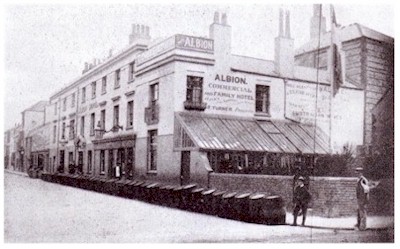 |
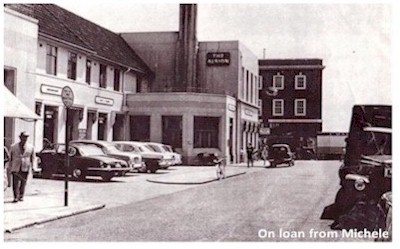 |
|
|
|
 |
The images above show the
Albion Hotel as viewed from
Montague Street and secondly from Portland Road, looking south with
Marks & Spencer's before it was extended across Portland Road making
it shorter.
Right: looking west down Montague Street with the Albion on the
right. Opposite there is a chapel as Portland Road was original
Chapel street. The name was later changed so as not to confuse it
with Chapel Road. Boots the Chemist stands in the Chapels place
today.
Thomas Russell, the Albion's first landlord was also the son of
Worthing's first postman. |
| |
|
|
1894 |
| |
|
|
1894:
The Worthing Gazette begins an article with: "In recent years the
Albion Hotel seems to have lost some of the prestige it formerly
possessed, but a well-directed effort is now being made to restore
it to its original condition of prosperity."
It goes on to describe how the Montague frontage was a wasted
indulgence of garden and greenhouse, which was now demolished, and
the building was extended to its full length, creating a structure
of 'imposing proportions'.
An eye had been cast on the commercial aspect of the building, with
a 17-foot sitting room and a 19-foot dining room. The old bar had
been entirely removed, and a new corridor cut through the building
on the ground floor. |
A new
hall had been created, being some 35 feet long by 16 feet wide, with
a grand staircase of polished Oregon pine and mahogany. A separate
staircase was installed to allow access to the billiard room without
entering the hotel.
A private saloon bar was off the main hall. A public bar remained.
The total frontage, including the new wing, is 162 feet, being made
up of 130 feet in Chapel Street (now Portland Road) and 32 feet in
Montague Street. There are 21 bedrooms. There is an extensive cellar
and stabling.
The article ends: "The present manager, Mr E W Searle, may be
expected to do well with the admirably equipped hotel of which he
now finds himself in possession." |
| |
|
| |
| |
|
|
The name 'Albion' is
considered to be the ancient Greek name for the Island of Great
Britain. The Romans preferred 'Britannia', and so it is easy to see
how these once common pub names came into being. I believe the
original pub sign from the fifties and sixties depicted a knight
with the red cross of St. George on his shield. A clue perhaps is
shown in the picture to the right.
The Albion Commercial & Family Hotel was a Georgian period building
dating from around 1800 and situated in what was then Chapel Street
on the site of White & Browns livery stables which accounts for it
occupying a large site with parking on the west side.
Just beyond Marks & Spencer's you can just make out the lost section
of Portland Road |
 |
| |
|
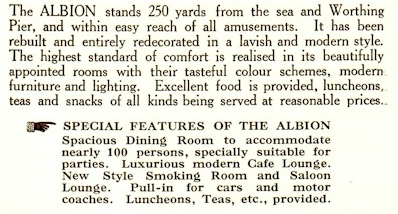 |
The Albion was rebuilt around
1935 and closed in 1961. The subsequent development contained
Gamley's toy store. A later redevelopment replaced this with the
Superdrug store that stands in its place today.
As you can see from the advert opposite, it catered for families and
those on a seaside holiday or day trip.
Many of the larger hotels catered for the drinking classes with a
public bar. Guests on the other hand, had a saloon, lounge and
smoking room. Other establishments had a separate building or known
as 'shades' with a more spit and sawdust feeling. |
| |
|
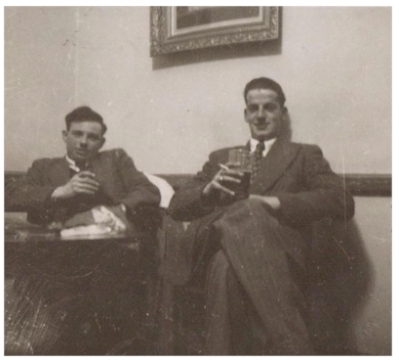 |
Thanks to Steve Bray to use
this picture. Labelled as 'Smoke room of the Albion Jan 1951 with
Ken'. On the right is Les Bray - father of Steve. Ken remains
unknown.
Thanks to The Hatchard's for
this 1953 picture above. |
| |
|
|
1962 |
| |
|
|
On Friday,
15th June 1962, the Worthing Herald announced that the Albion Hotel
had been sold.
Properties manager F Ellick, of Brickwoods Ltd informed the Herald
that contracts had been exchanged. The site had been bought by B and
W Linens Ltd of Chiswick, who own many shops throughout the country.
They specialise in household linens and furnishings.
Pub manager Jim Clark and his wife Nora had been at the Albion Hotel
for 10 years. "We are very sorry to leave, we have been happy here."
There had been rumours for many years that the Albion was to be sold
for shop purposes. |
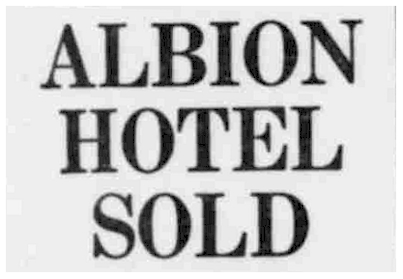 |
| |
|
| |
| |
|
 |
| |
|
|
Time
Line |
A
little bit extra |
|
1855 -
1867 Thomas Russell
1879 - Ernest Baker
1883 - Thomas Towner
1883 - Lease for sale
1894 - EW Searle
1897 - 1905 Edward (Ted) Roffey
1915 - Samuel Kramer Suckley
1931 - J Howell
1934 - Rebuilt
1957 - Mr & Mrs Clark
1961 - Closed - demolished
 |
From Christopher Noble,
Western Front Association, West Yorkshire.
Just came across your site as regards the above during the course of
some military history research. One thing I can add is that circa
May/June 1915, the Landlord (own business) was one Samuel Kramer
Suckley, a Professor of Music and a native of Harrogate. Suckley was
demobilised in the months above from the Yorkshire Hussars to "work
on own business Albion Hotel, Worthing." It would appear that this
was of a short duration however and if I read this correctly,
between the 24th of June - 19th of August 1915 whereupon he once
again rejoined the Yorkshire Hussars.
1893: The entire contents of the
hotel were sold off due to the typhoid epidemic. |
| |
|
| |
| |
|
 |
| |
|
| |
|